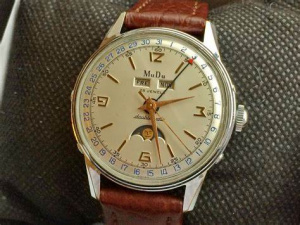Difference between revisions of "MuDu"
| Line 11: | Line 11: | ||
From the mid 1950s and through the whole of the 1960s, MuDu watches were smuggled into the UK through various ports of entry, including Southampton and the old City of Bristol docks. They were then sold in pubs and other "unofficial" outlets, with no retail shops selling them. When the watches were smuggled in, probably to avoid the high duty imposed post-War on various imported goods, they apparently had no straps. The UK was the main export market for MuDu watches. | From the mid 1950s and through the whole of the 1960s, MuDu watches were smuggled into the UK through various ports of entry, including Southampton and the old City of Bristol docks. They were then sold in pubs and other "unofficial" outlets, with no retail shops selling them. When the watches were smuggled in, probably to avoid the high duty imposed post-War on various imported goods, they apparently had no straps. The UK was the main export market for MuDu watches. | ||
| − | There is a story of smuggled goods being seized from a well-know London gangster in 1961. It is reported that MuDu were in the haul. One on watch forum (https://www.christopherwardforum.com/viewtopic.php?f=8&t=32312&start=15 | + | There is a story of smuggled goods being seized from a well-know London gangster in 1961. It is reported that MuDu were in the haul. One on watch forum ([https://www.christopherwardforum.com/viewtopic.php?f=8&t=32312&start=15 Christopher Ward]) a member said ' I purchased a MuDu 25 jewel doublematic for about £5 from a Customs & Excise sale of seized goods in 1961.' |
| − | ) a member said ' I purchased a MuDu 25 jewel doublematic for about £5 from a Customs & Excise sale of seized goods in 1961.' | + | |
| + | The Swiss-made watches were of pretty decent quality and often had multi-jewelled movements, usually made by [[Felsa]]. The better models were also found in solid gold cases. They can be seen engraved as long-service or retirement gifts from companies located normally in Southern England. | ||
| − | |||
==Notable Models== | ==Notable Models== | ||
The most well-known term associated with MuDu is "Doublematic" and this refers to the use of Felsa movements in which the rotor moves both ways thereby winding the watch in both directions - similar to a bumper movement. Some Doublematic watches have the Felsa 1560 movement, while others use the Felsa 4002 movement and MuDu watches with the latter movement having been noted with 25, 30 and even 41 jewels. S0metimes the jewel count is even higher and there are reports of 55 and 56 jewel dials. | The most well-known term associated with MuDu is "Doublematic" and this refers to the use of Felsa movements in which the rotor moves both ways thereby winding the watch in both directions - similar to a bumper movement. Some Doublematic watches have the Felsa 1560 movement, while others use the Felsa 4002 movement and MuDu watches with the latter movement having been noted with 25, 30 and even 41 jewels. S0metimes the jewel count is even higher and there are reports of 55 and 56 jewel dials. | ||
Revision as of 16:17, 25 April 2020
MuDu
A Swiss maker with a strange history! Notable wearers include Beatles producer George Martin
History
The history of MuDu watches begins in about 1955, with the name apparently being registered in Switzerland on 5 July 1957 and listed as belonging to Brevinex SA/Kurt Dubach, Geneva Switzerland. There is a rumour that MuDu watches were actually made as a secondary brand of Blancpain watches, with a further notion that Blancpain workers made the watches out of hours. This rumour, which seems to have little credence, may stem from the rather illicit manner in which MuDu watches entered Britain, lending the watches an air of mystery. In the registration of the MuDu name, the manufacturer is stated as also making clocks, chronometers, and stopwatches.
From the mid 1950s and through the whole of the 1960s, MuDu watches were smuggled into the UK through various ports of entry, including Southampton and the old City of Bristol docks. They were then sold in pubs and other "unofficial" outlets, with no retail shops selling them. When the watches were smuggled in, probably to avoid the high duty imposed post-War on various imported goods, they apparently had no straps. The UK was the main export market for MuDu watches.
There is a story of smuggled goods being seized from a well-know London gangster in 1961. It is reported that MuDu were in the haul. One on watch forum (Christopher Ward) a member said ' I purchased a MuDu 25 jewel doublematic for about £5 from a Customs & Excise sale of seized goods in 1961.'
The Swiss-made watches were of pretty decent quality and often had multi-jewelled movements, usually made by Felsa. The better models were also found in solid gold cases. They can be seen engraved as long-service or retirement gifts from companies located normally in Southern England.
Notable Models
The most well-known term associated with MuDu is "Doublematic" and this refers to the use of Felsa movements in which the rotor moves both ways thereby winding the watch in both directions - similar to a bumper movement. Some Doublematic watches have the Felsa 1560 movement, while others use the Felsa 4002 movement and MuDu watches with the latter movement having been noted with 25, 30 and even 41 jewels. S0metimes the jewel count is even higher and there are reports of 55 and 56 jewel dials.
Pick of the bunch is the classic 1960s triple date Moonphase.
Summary
The full story may never be known about MuDu... Were they:
- secretly made by workers of Blancpain from stolen parts? Most likely untrue.
- smuggled into the UK to get around customs duties, through the docks at Bristol and Southampton, and sold in portside pubs? Most likely true.
- simply a brand name of Muller and Durbach in Geneva? Probably.

